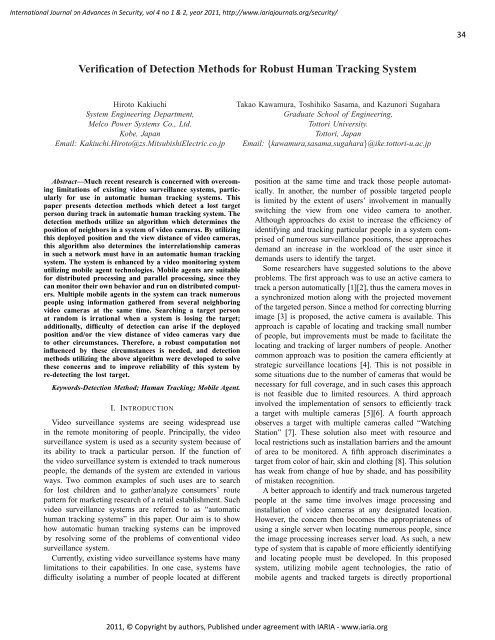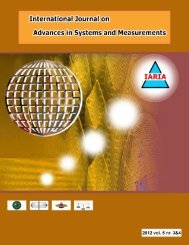Fault Tolerance Framework using Model-Based - IARIA Journals
Fault Tolerance Framework using Model-Based - IARIA Journals
Fault Tolerance Framework using Model-Based - IARIA Journals
You also want an ePaper? Increase the reach of your titles
YUMPU automatically turns print PDFs into web optimized ePapers that Google loves.
International Journal on Advances in Security, vol 4 no 1 & 2, year 2011, http://www.iariajournals.org/security/<br />
Verification of Detection Methods for Robust Human Tracking System<br />
Hiroto Kakiuchi<br />
System Engineering Department,<br />
Melco Power Systems Co., Ltd.<br />
Kobe, Japan<br />
Email: Kakiuchi.Hiroto@zs.MitsubishiElectric.co.jp<br />
Abstract—Much recent research is concerned with overcoming<br />
limitations of existing video surveillance systems, particularly<br />
for use in automatic human tracking systems. This<br />
paper presents detection methods which detect a lost target<br />
person during track in automatic human tracking system. The<br />
detection methods utilize an algorithm which determines the<br />
position of neighbors in a system of video cameras. By utilizing<br />
this deployed position and the view distance of video cameras,<br />
this algorithm also determines the interrelationship cameras<br />
in such a network must have in an automatic human tracking<br />
system. The system is enhanced by a video monitoring system<br />
utilizing mobile agent technologies. Mobile agents are suitable<br />
for distributed processing and parallel processing, since they<br />
can monitor their own behavior and run on distributed computers.<br />
Multiple mobile agents in the system can track numerous<br />
people <strong>using</strong> information gathered from several neighboring<br />
video cameras at the same time. Searching a target person<br />
at random is irrational when a system is losing the target;<br />
additionally, difficulty of detection can arise if the deployed<br />
position and/or the view distance of video cameras vary due<br />
to other circumstances. Therefore, a robust computation not<br />
influenced by these circumstances is needed, and detection<br />
methods utilizing the above algorithm were developed to solve<br />
these concerns and to improve reliability of this system by<br />
re-detecting the lost target.<br />
Keywords-Detection Method; Human Tracking; Mobile Agent.<br />
I. INTRODUCTION<br />
Video surveillance systems are seeing widespread use<br />
in the remote monitoring of people. Principally, the video<br />
surveillance system is used as a security system because of<br />
its ability to track a particular person. If the function of<br />
the video surveillance system is extended to track numerous<br />
people, the demands of the system are extended in various<br />
ways. Two common examples of such uses are to search<br />
for lost children and to gather/analyze consumers’ route<br />
pattern for marketing research of a retail establishment. Such<br />
video surveillance systems are referred to as “automatic<br />
human tracking systems” in this paper. Our aim is to show<br />
how automatic human tracking systems can be improved<br />
by resolving some of the problems of conventional video<br />
surveillance system.<br />
Currently, existing video surveillance systems have many<br />
limitations to their capabilities. In one case, systems have<br />
difficulty isolating a number of people located at different<br />
Takao Kawamura, Toshihiko Sasama, and Kazunori Sugahara<br />
Graduate School of Engineering,<br />
Tottori University.<br />
Tottori, Japan<br />
Email: {kawamura,sasama,sugahara}@ike.tottori-u.ac.jp<br />
position at the same time and track those people automatically.<br />
In another, the number of possible targeted people<br />
is limited by the extent of users’ involvement in manually<br />
switching the view from one video camera to another.<br />
Although approaches do exist to increase the efficiency of<br />
identifying and tracking particular people in a system comprised<br />
of numerous surveillance positions, these approaches<br />
demand an increase in the workload of the user since it<br />
demands users to identify the target.<br />
Some researchers have suggested solutions to the above<br />
problems. The first approach was to use an active camera to<br />
track a person automatically [1][2], thus the camera moves in<br />
a synchronized motion along with the projected movement<br />
of the targeted person. Since a method for correcting blurring<br />
image [3] is proposed, the active camera is available. This<br />
approach is capable of locating and tracking small number<br />
of people, but improvements must be made to facilitate the<br />
locating and tracking of larger numbers of people. Another<br />
common approach was to position the camera efficiently at<br />
strategic surveillance locations [4]. This is not possible in<br />
some situations due to the number of cameras that would be<br />
necessary for full coverage, and in such cases this approach<br />
is not feasible due to limited resources. A third approach<br />
involved the implementation of sensors to efficiently track<br />
a target with multiple cameras [5][6]. A fourth approach<br />
observes a target with multiple cameras called “Watching<br />
Station” [7]. These solution also meet with resource and<br />
local restrictions such as installation barriers and the amount<br />
of area to be monitored. A fifth approach discriminates a<br />
target from color of hair, skin and clothing [8]. This solution<br />
has weak from change of hue by shade, and has possibility<br />
of mistaken recognition.<br />
A better approach to identify and track numerous targeted<br />
people at the same time involves image processing and<br />
installation of video cameras at any designated location.<br />
However, the concern then becomes the appropriateness of<br />
<strong>using</strong> a single server when locating numerous people, since<br />
the image processing increases server load. As such, a new<br />
type of system that is capable of more efficiently identifying<br />
and locating people must be developed. In this proposed<br />
system, utilizing mobile agent technologies, the ratio of<br />
mobile agents and tracked targets is directly proportional<br />
2011, © Copyright by authors, Published under agreement with <strong>IARIA</strong> - www.iaria.org<br />
34







